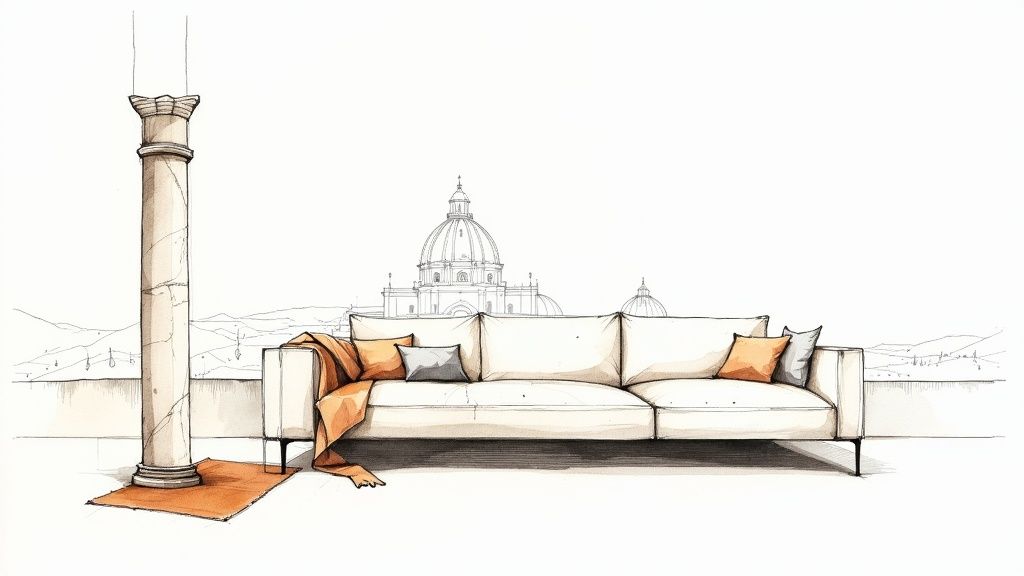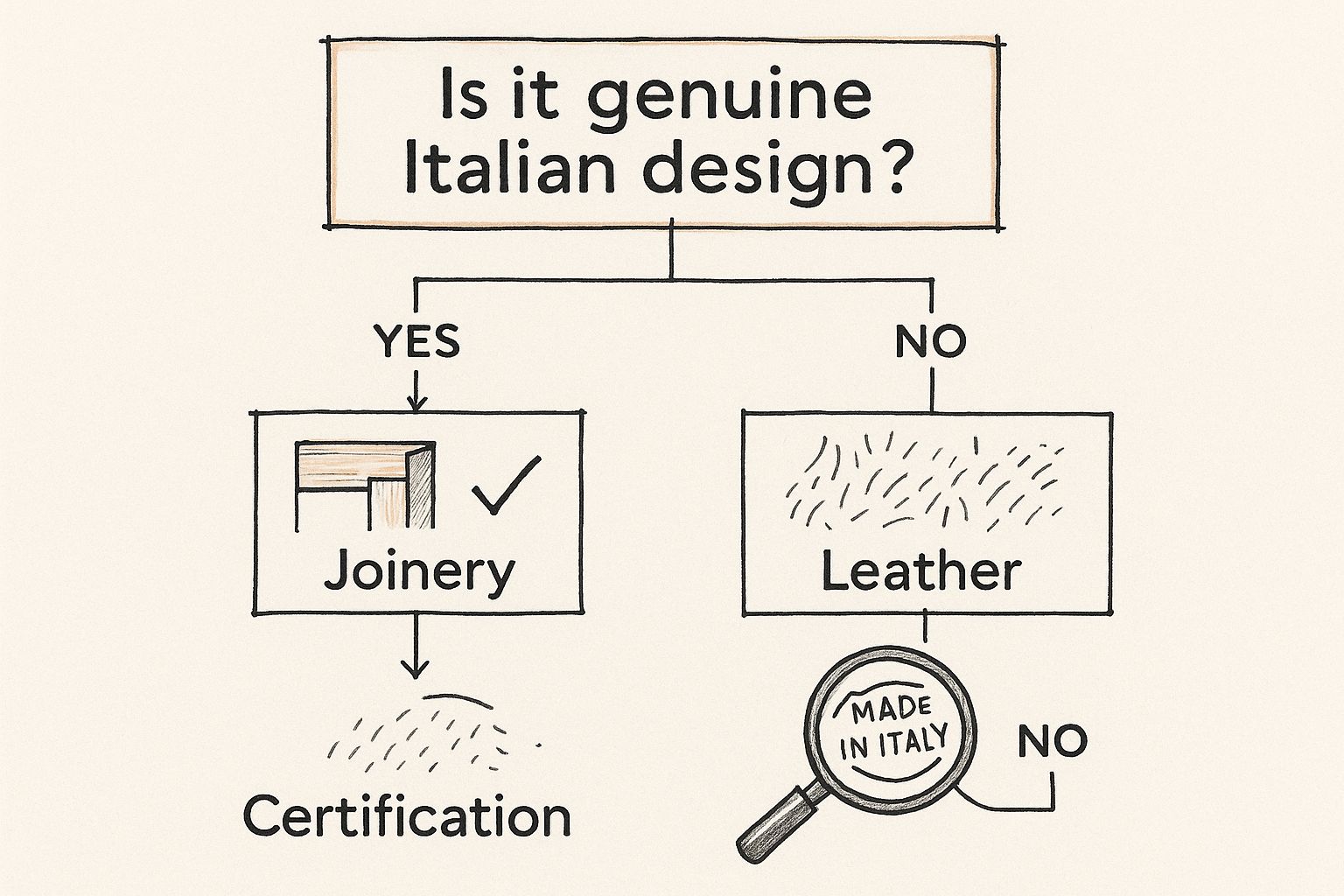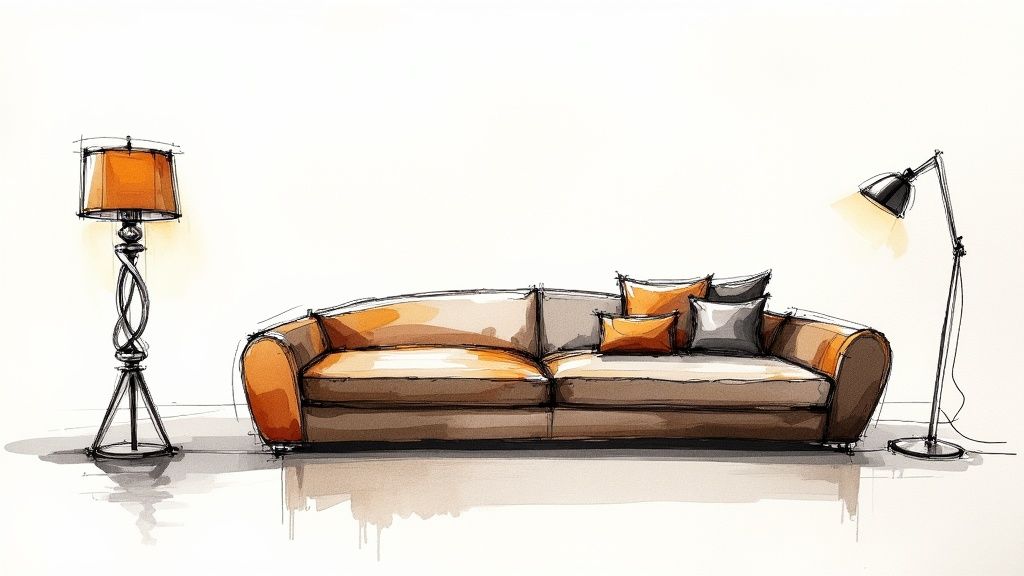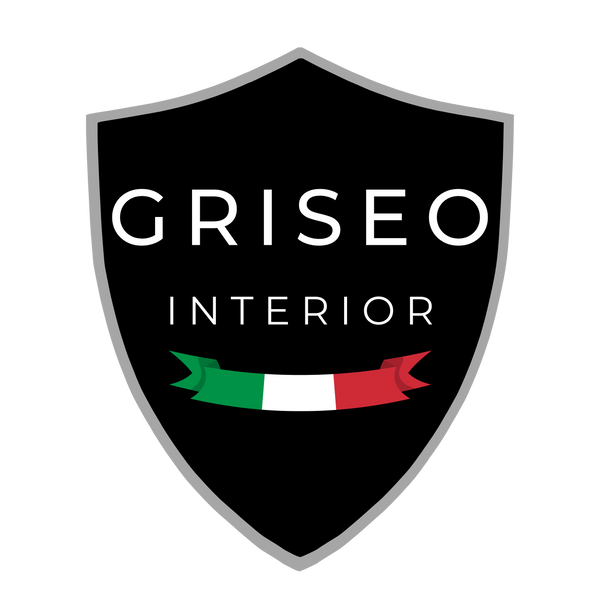
A Practical Guide to Choosing Authentic Made in Italy Design
“Made in Italy” is more than a label; it’s a promise of quality, heritage, and a deep passion for beauty. But how do you, as a discerning buyer, translate that promise into a real, tangible object for your home? This guide will give you the actionable advice you need to identify, select, and integrate authentic Italian design with confidence. It’s about moving beyond the romance of the label and making a smart, lasting investment.
What Does Made in Italy Truly Mean for You?

Those three words signal luxury, craftsmanship, and enduring style. But for a buyer, their true weight comes from what they guarantee: a product born from a philosophy where beauty and function are inseparable, and where an artisan's skill is paramount. When you see "Made in Italy," you should expect an object created with a tangible human touch.
This label is your assurance that you’re buying something created from generations of passed-down wisdom. Think of a family of woodworkers in Tuscany passing down joinery techniques, or Murano glassblowers whose methods have been refined for centuries. Your purchase supports this lineage of skill.
The Philosophy Behind the Label
At its core, "Made in Italy" means a commitment to excellence from start to finish. It’s the direct opposite of mass production. It’s about deliberate, mindful creation. This philosophy demands the finest raw materials—whether that’s a flawless slab of Carrara marble for a tabletop or full-grain leather for a sofa.
This approach also ensures a perfect harmony between innovation and tradition. Italian designers are experts at creating pieces that feel completely modern yet absolutely timeless, ensuring they’ll look just as incredible in thirty years as they do today. This is the practical benefit: you are buying an asset, not a trend.
"Choosing a 'Made in Italy' piece is an investment in a story. It’s about bringing an object into your home that was crafted with intention, skill, and a deep respect for the art of making."
When you bring an authentic Italian piece into your home, you're not just decorating. You're making a conscious choice to embrace things built to last—turning your home into a curated space of future heirlooms.
Decoding the DNA of Italian Craftsmanship
So, what should you look for in a “Made in Italy” piece? It’s a powerful blend of three core pillars that create an undeniable standard of excellence. Understanding this DNA—woven from heritage, materials, and innovation—is your key to recognizing a true masterpiece.
Consider the journey of a single armchair. It doesn't begin on an assembly line, but as an idea shaped by generations of skill. This is the first pillar to look for: artisanal heritage. This means seeking out techniques that no machine can replicate. Look for the subtle curve of a hand-carved leg or the perfect, even tension in a hand-stitched seam.
This human touch creates objects with soul. Each artisan imparts a piece of their own story into their work, which is why every item feels so personal and alive.
A Foundation of Superior Materials
Next, an armchair needs its frame and fabric. This brings us to the second pillar: an uncompromising pursuit of superior materials. To assess this, you must engage your senses.
Italian artisans source materials with an obsessive dedication to quality. When buying, look for the world-renowned beauty of veined Carrara marble, quarried from the very same mountains Michelangelo used, or feel the supple, yet incredibly durable, strength of full-grain Tuscan leather.
This commitment extends to every component. The selection process is meticulous because these creators know that authentic, high-quality materials don't just look and feel better—they also age gracefully, developing a rich patina and character that tells a story over time.
For Italian creators, materials are not just inputs; they are the heart of the design. The specific grain of the wood or the unique texture of the stone often inspires the final form of the piece itself.
This deep reverence for raw materials is a critical part of the "Made in Italy" promise, ensuring both longevity and a beauty that never fades. This unwavering standard is a key reason why Italian goods are in such high demand across the globe.
Italy’s export economy is a cornerstone of its national GDP, with exports accounting for about one-third of the country’s economic output. The international reputation of "Made in Italy" products, particularly in sectors like furniture, drives this consistent global desire for quality. You can explore more data on Italy's powerful export market and see how this reputation translates directly into economic strength.
The Spark of Quiet Innovation
Finally, that armchair must fit into a modern home. This is the third pillar: a culture of quiet innovation. While respectful of tradition, Italian design is not stuck in the past. It is constantly evolving, blending timeless techniques with a contemporary vision.
This is where the real magic happens for today's homeowners. Designers and artisans reimagine classic forms for modern interiors. They experiment with new technologies and unexpected finishes without sacrificing the integrity of their craft. For a deeper look into this beautiful balance, you might be interested in exploring our guide on Italian contemporary interior design.
This forward-thinking approach ensures that "Made in Italy" remains relevant and exciting. It's a practical blend of a rich history and a fearless embrace of the future, resulting in pieces that feel both classic and completely of the moment.
From the artisan's hands to the choice of materials to the spark of modern design, these three pillars form the unbreakable DNA of Italian craftsmanship. Use them as your guide to appreciate the artistry, integrity, and soul poured into every creation.
How to Spot Authentic Italian Design
Entering the world of Italian décor requires a discerning eye. To ensure you're investing in a piece that truly carries the ‘Made in Italy’ legacy, you need to learn how to look beyond the surface. This is your practical guide to becoming a confident buyer, ready to distinguish a masterpiece from a clever imitation.
Think of yourself as an inspector. The clues are all there, waiting in the details.
The first place to look is the joinery and stitching. In authentic Italian furniture, the joints are flawless and precise, often crafted with time-honored techniques like dovetail or mortise-and-tenon. They’re built for both beauty and strength.
Next, get hands-on with the upholstery. Run your hand over the seams of a sofa or chair. A genuine piece will have tight, even, and consistent stitching—the signature of a skilled artisan. In contrast, mass-produced items often show puckered seams, loose threads, or uneven lines, revealing the haste of an automated process.
Feel the Difference in Materials
Your sense of touch is your most powerful tool. Authentic Italian design is built on incredible raw materials, and you can often feel the difference instantly. Real leather, for instance, feels supple and has a distinct, rich aroma. It will also have subtle, natural imperfections.
In contrast, synthetic leathers feel stiff, unnaturally uniform, and may have a faint chemical smell. The same goes for wood. Solid wood has a satisfying weight and a unique grain pattern, whereas cheaper veneers can feel light, hollow, and have repetitive, printed patterns. Don't be afraid to touch, lift, and examine the materials—they tell a story of quality, or a lack thereof.
A genuine "Made in Italy" object speaks through its textures. The cool, smooth surface of real marble, the warmth of solid oak, and the soft yield of full-grain leather are signatures of authenticity that simply cannot be faked.
This tactile investigation is a crucial step. It confirms you're investing in an heirloom built to last for generations, not a fleeting trend.
Look for Official Marks and Documentation
While a maker's mark is a good starting point, serious buyers should dig deeper. Many high-end Italian brands provide certificates of authenticity. This paperwork is your proof, verifying the origin, materials, and sometimes even the artisan who created it.
Beyond that, some products bear legal certifications guaranteeing their Italian origins. The “100% Made in Italy” certification, for example, is an official mark issued by the Institute for the Protection of Italian Manufacturers. It guarantees the entire production cycle, from design to final assembly, took place on Italian soil.
- Brand Stamp or Signature: Look for a cleanly embossed, engraved, or branded mark. A poorly applied or blurry logo is a major red flag.
- Certificate of Authenticity: Always ask the seller if the piece comes with official paperwork. This is standard for luxury furniture, lighting, and limited-edition décor.
- Legal Certifications: Inquire about official seals like the “100% Made in Italy” mark for an extra layer of confidence in your purchase.
Think of these formal verifications as your passport, confirming the piece's legitimate journey from an Italian workshop to your home.
This simple decision tree illustrates the key checkpoints for verifying authentic Italian design, from examining joinery to checking for official certifications.

As you can see, authenticity isn’t confirmed by a single factor, but by a combination of tangible quality markers and official proof.
Authenticity Checklist for Italian Décor
Before you commit, run through this quick checklist. Use it to arm yourself with knowledge and ensure you're bringing home a truly authentic piece of Italian craftsmanship.
| Attribute to Check | What to Look For (Genuine) | Red Flags (Potential Fake) |
|---|---|---|
| Workmanship | Seamless joints, even stitching, flawless finish. | Gaps in joinery, loose threads, puckered seams. |
| Materials | Solid wood with unique grain, supple leather, weighty marble. | Lightweight veneers, stiff synthetic fabrics, hollow feel. |
| Branding | Crisp, clear, and well-placed maker’s mark or logo. | Blurry, misplaced, or poorly applied logos. |
| Documentation | Certificate of Authenticity, "100% Made in Italy" seal. | No paperwork, vague origins, refusal to provide details. |
| Seller Reputation | Authorized dealer, transparent about sourcing. | Unverifiable seller, "too good to be true" pricing. |
Trusting your senses and asking the right questions will guide you toward a piece you’ll treasure for a lifetime.
Beware of "Italian Sounding" Deceptions
One of the biggest pitfalls for buyers is the "Italian Sounding" phenomenon. This is when a product uses an Italian-sounding name, the Italian flag, or Tuscan imagery to trick you into thinking it's genuine when it was actually produced elsewhere.
This tactic is common in the furniture and décor market. A brand name ending in a vowel or a description like "Tuscan style" means nothing without proof of origin.
Always flip it over and check the label for the actual country of manufacture. Authentic brands are incredibly proud of their heritage and will state "Made in Italy" clearly and confidently. By being aware of this, you protect your investment and support the true artisans who uphold this legacy.
Bring Italian Elegance into Your Home

Now that you know how to spot the real deal, here’s how to weave that Italian sophistication into your home. The goal isn't to create a museum but a living space that feels curated and personal. The most effective strategy is to start with one incredible piece.
A single, sculptural Artemide lamp doesn't just light a corner; it introduces a new energy to the entire room. This is the secret of the Italian approach: lead with one statement piece that has a story to tell, and let the rest of the room follow its lead.
This focal point becomes your anchor. It could be a velvety Poltrona Frau armchair, a clean-lined marble coffee table, or a stunning, hand-blown vase. Once in place, it will naturally guide your other design choices, helping you build a room with character.
Balance Timeless Craft with Modern Life
Bringing made in Italy décor into your home is about creating a dialogue between old and new. You don’t need a complete overhaul. Instead, create beautiful contrasts that let the unique character of your Italian pieces shine.
For example, set a hand-stitched leather sofa against a crisp, modern wall. Or hang an ornate Murano glass chandelier above a simple, unadorned dining table. This tension between timeless craftsmanship and your contemporary style creates a dynamic space that feels both grounded and fresh.
If your taste leans minimalist, Italian design principles fit perfectly. To see how this can work, find inspiration in our guide to creating a beautifully minimalist home. The key is giving each object enough space to breathe so its form and quality can be fully appreciated.
Use Rich Textures to Create Depth
Italian design is an experience for the senses. Layering different textures is vital for bringing that spirit into your home. Move beyond just color and think about how materials play off one another to build warmth and complexity.
"True Italian elegance isn't just seen; it's felt. The interplay of smooth leather, rough-hewn wood, cool metal, and soft textiles is what gives a space its soul and invites you to truly live in it."
Here are a few simple strategies to get you started:
- Combine Hard and Soft: Juxtapose the cool, smooth surface of a marble tabletop with the warmth of a plush wool rug underfoot.
- Play with Sheen: Mix matte finishes with high-gloss accents. A lacquered sideboard paired with a linen-covered armchair, for instance, creates a sophisticated visual contrast.
- Introduce Natural Elements: Weave in raw wood, stone, or natural textiles. These organic touches add an earthy feel that beautifully balances more polished, refined pieces.
This thoughtful layering elevates a room from looking staged to feeling alive and genuinely inviting. It's this mastery of materials that has made the furniture sector a pillar of Italy's economy. In fact, Italian exports—led by furniture with a 6.0% global market share—are a testament to the world's enduring love for this level of quality.
Master the Art of Italian Lighting
No Italian-inspired home is complete without a smart lighting plan. In Italy, light is treated as a design material—a tool used to sculpt spaces, create intimacy, and set the mood. It’s all about creating emotion through function.
To master this, think in layers. Every room should have multiple light sources that you can adjust for any occasion.
- Ambient Lighting: This is your foundation, the overall glow from a central fixture like a chandelier or a sleek pendant.
- Task Lighting: This is focused light for specific activities. Use an elegant floor lamp next to a reading chair or discreet under-cabinet lighting in the kitchen.
- Accent Lighting: This is the artistic touch. Use it to highlight architecture, artwork, or your most cherished décor. Sculptural table lamps and subtle spotlights are perfect for this.
By combining these three layers, you gain complete control over your home's atmosphere. You can create a bright, energizing space for a daytime gathering or a soft, intimate glow for a quiet evening, all with the flick of a switch. This nuanced approach is the final, essential touch for bringing Italian elegance home.
The Enduring Value of Investing in Authenticity
Choosing a genuine ‘Made in Italy’ piece isn't just a purchase; it's a practical decision to embrace lasting value. You're not just buying an object; you're investing in a story, unparalleled quality, and a more sustainable future for your home.
When you bring an authentic Italian creation into your life, you’re choosing something built to stand the test of time. These are not objects designed to be replaced. They are tomorrow's heirlooms, crafted with such skill that their beauty and purpose will be enjoyed for generations. Imagine a solid wood dining table that will be the heart of family gatherings for decades, or a leather armchair that grows more beautiful with every passing year.
Moving Beyond Fast Furniture
This commitment to longevity is a powerful action against the wasteful cycle of "fast furniture." By choosing one exceptional piece over several mass-produced ones, you shape a home that is more intentional and sustainable. It’s a tangible step toward consuming less and curating a space filled only with objects that bring you true joy.
This approach doesn't just cut down on waste; it enriches your life.
- Smarter Financially: The upfront cost might be higher, but the lifetime value is incomparable. You avoid the endless cycle of buying and replacing poorly made items.
- Deeper Connection: You forge a meaningful bond with objects meant to be part of your story, creating a home that reflects your values.
- A Kinder Choice for the Planet: Opting for durable design is one of the most direct ways to support a healthier planet. Discover more ways to make sustainable choices in our guide to eco-friendly home accents.
Supporting a Legacy of Craftsmanship
Your investment sends ripples far beyond your home. It directly supports the small, often family-run workshops that are the soul of the ‘Made in Italy’ legacy. These studios are living cultural treasures, safeguarding skills passed down through centuries.
Choosing authentic Italian design is an act of cultural preservation. You become a patron of an art form, helping ensure these invaluable traditions of craftsmanship not only survive but thrive for generations to come.
This choice helps fuel a vital economic ecosystem. In the first quarter of 2025 alone, Italy's exports were valued at an incredible €160.1 billion. This figure represented a 3.2% increase in value, underscoring the world's unwavering appetite for the high-quality, masterfully crafted goods these artisans produce. You can discover more about the strength of Italy's export market and see how every mindful purchase plays a part.
When you invest in an authentic piece, you're embracing a philosophy of quality over quantity, championing sustainability, and becoming a guardian of a priceless cultural heritage. The return you get isn't just in the material, but in the meaning, story, and enduring legacy you welcome into your life.
Your Questions on Italian Design Answered
Embarking on a journey into Italian design always brings up a few questions. To help you feel confident and inspired, here are answers to some of the most common queries.
Why Are Made in Italy Pieces Often More Expensive?
The price of a genuine Italian piece reflects its true cost: superior, often locally sourced raw materials and the countless hours of a master artisan who has honed their skills over generations. You are paying for a legacy of quality.
Think of it this way: you're not just buying a chair, you're investing in an item built with a design philosophy that champions longevity over fleeting trends. It is destined to be passed down and cherished for years, making its lifetime value much higher than disposable alternatives.
How Do I Care For My Italian Furniture?
Proper care ensures your Italian furniture will get better with age. The secret is to follow the specific care instructions from the maker, as every material has unique needs.
Here are a few practical rules of thumb:
- For Wood: Dust regularly with a soft cloth and keep it out of direct sunlight to prevent fading.
- For Leather: Every 6-12 months, apply a high-quality leather conditioner to keep the material supple and prevent cracking.
- For Marble: Clean up spills immediately with a pH-neutral cleaner to prevent etching. Always use coasters.
Is It Better to Buy One Expensive Piece or Several Cheaper Items?
This question gets to the heart of the Italian design philosophy: quality over quantity. Choosing one authentic, made in Italy piece over several mass-produced alternatives is a practical decision to invest in something that lasts. A single, exceptionally crafted item can elevate an entire room and will outlast its cheaper counterparts, making it a smarter and more sustainable choice in the long run.
"Investing in a single, beautifully made object is more rewarding than filling a space with things that lack soul. It’s about curating a home with intention and surrounding yourself with pieces that tell a meaningful story."
This mindset shifts your perspective from merely decorating to curating a home. It's a rewarding journey of building a collection of cherished items that grow with you, rather than contributing to the cycle of disposable decor. It’s how you bring lasting beauty and real character into your life.
At Griseo Interior, we bring this legacy into the modern home. Discover our collection of minimalist, artisan-crafted décor, designed and made in Italy for a life of intentional beauty. Start your design journey today at griseointerior.com.
